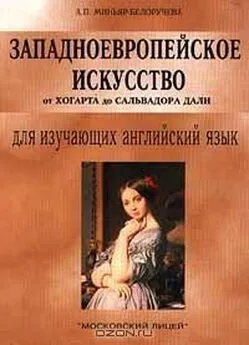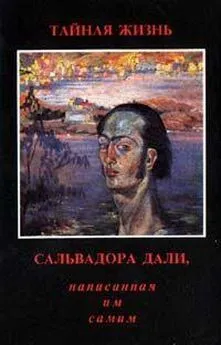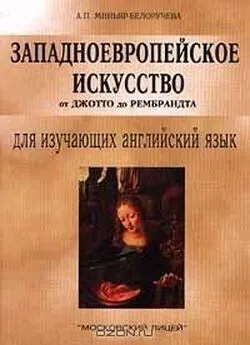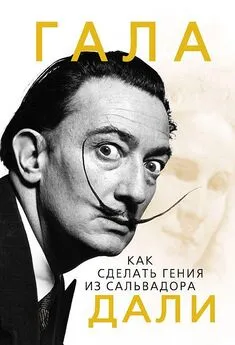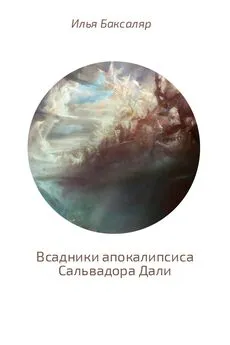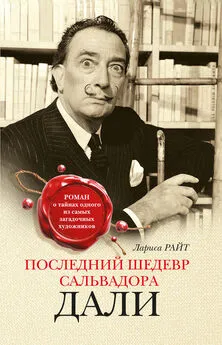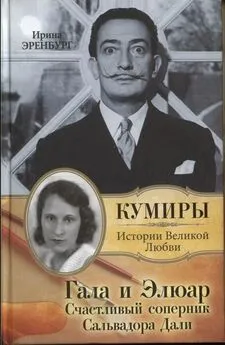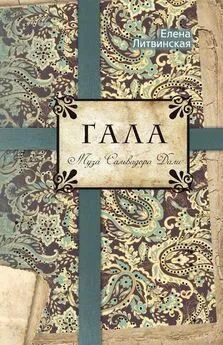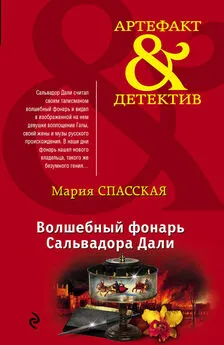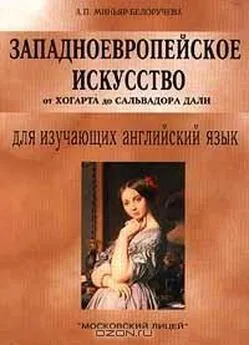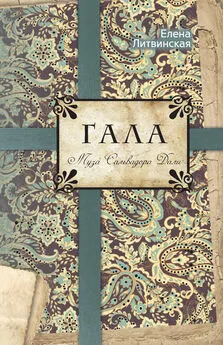Алла Миньяр-Белоручева - Западноевропейское искусство от Хогарта до Сальвадора Дали
- Название:Западноевропейское искусство от Хогарта до Сальвадора Дали
- Автор:
- Жанр:
- Издательство:«Московский Лицей»
- Год:1999
- Город:Москва
- ISBN:5-7611-0182-3
- Рейтинг:
- Избранное:Добавить в избранное
-
Отзывы:
-
Ваша оценка:
Алла Миньяр-Белоручева - Западноевропейское искусство от Хогарта до Сальвадора Дали краткое содержание
Тексты настоящего пособия охватывают почти три века истории западноевропейского искусства от Хогарта до Сальвадора Дали. Это позволяет обучаемым наряду с усвоением обширного лексического материала, приобрести культурологические знания, поскольку тексты содержат информацию о жизни и творчестве крупнейших западно-европейских художников XVIII – XX вв. Система упражнений направлена на усвоение лексического материала и развитие навыков устной речи.
Данная книга является второй частью цикла учебных пособий «Западноевропейское искусство (для изучающих английский язык)». В первую книгу вошли тексты, охватывающие пять веков западноевропейской живописи oт Джотто до Рембрандта. Данное пособие предназначено для студентов-искусствоведов, учащихся классических гимназий, лицеистов и всех изучающих английский язык и интересующихся западноевропейским искусством.
Западноевропейское искусство от Хогарта до Сальвадора Дали - читать онлайн бесплатно полную версию (весь текст целиком)
Интервал:
Закладка:
Goya's passionate humanity speaks uncensored through his engravings. Goya made several series of etching-aquatints, the earliest of which Los Caprichos (The Caprices) , of 1796-98, is widely imaginative. The first section, dealing satirically with events from daily life, is surpassed by the second, devoted to fantastic events enacted by monsters, witches, and malevolent nocturnal beasts from the demonic tradition of Spanish folklore.
The introductory print of the second section shows the artist asleep at his table loaded with idle drawing instruments, before which is propped a tablet inscribed «El sueno de la razon produce monstruos»(«the sleep of reason produces monsters»). Reason, the goddess of the 18-th century philosophers, once put to sleep, allows monsters to arise from the inner darkness of mind. Goya's menacing cat and the rising clouds of owls and bats glowing in light and dark are lineal descendants of the beasts of medieval art.
Instead of merely threatening human life, as in Los Caprichos , the monsters take over entirely in Goya's final series, Los Disparates (The Follies) , engraved between 1813 and 1819. The ultimate horror of Goya's imagination seethes through the series of dark frescoes the artist painted with fierce strokes on the walls of his own house from 1820 to 1822, depicting a universe dominated by unreason and terror, and making cruel mock of humanity.
One of Goya's rare references to Classical mythology illustrates the most savage of Greek legends. Saturn Devouring one of his Sons is an allegory of Time which engulfs us all. The glaring, mindless deity holds with colossal hands the body of his helpless son, from which he has torn and is chewing the head and the right arm – all indicated with brushstrokes of an unimagined ferocity.
Now nearing eighty, the great painter was not to live long with these creatures of his despairing imagination. After the restoration of a reactionary monarchic government in 1823, he left for France and died in exile.
Make sure you know how to pronounce the following words:
Francisco Goya; duchess; Alba; Daudet; Saturn; parody; bayonet; malevolent; nocturnal; demonic; caprices; lineal
Family of Charles IV – «Групповой портрет семьи короля Карла IV»
Maja Desnuda – «Маха обнаженная»
The Third of May, 1808, at Madrid: The Shooting on Principe Pio Mountain – «Расстрел испанских повстанцев французами в ночь на 3 мая 1808 г.»
Los Caprichos (The Caprices) – «Каприччос»
Los Disparates (The Follies) – «Диспаратес»
Saturn Devouring one of his Sons – «Сатурн, пожирающий одного из своих сыновей»
I. Read the text. Make sure you understand it. Mark the following statements true or false.
1. Goya's portraits of the royal court were influenced by Van Dyck.
2. The Family of Charles IV , painted in 1799, is an inspired parody of Velazquez's Las Meninas.
3. In 1786 Goya made several series of etching-aquatints.
4. In 1815 after the expulsion of the French from Spain the liberal government commissioned Goya a painting.
5. When Reason sleeps monsters arise from the inner darkness of mind.
6. The monarchy was restored in Spain in 1828.
II. How well have you read? Can you answer the following questions?
1. Was Goya a lifelong rebel against artistic and intellectual straitjackets? What artistic trend did Goya represent?
2. What is Goya's supreme achievement in portraiture? How many figures are portrayed in this portrait? How are the king and the queen depicted? How was this portrait characterised by Alfonce Daudet? What did Goya want to express by this portrait?
3. What is one of the most delightful paintings of the female nude in history? Is there any other version of this picture? How was the nude explained?
4. In what painting did Goya denounce the inhumanity of war? What does this work of art represent? How is the firing squad treated? How are the victims depicted?
5. What is represented in The Caprices ? What is pictured in the first section? What does the introductory print of the second section show? What did Goya paint on the walls of his own house?
6. What does one of Goya's rare references to Classical mythology illustrate? What does this work of art symbolise?
III. i. Give Russian equivalents of the following phrases:
the greatest artistic genius; at the turn of the century; the supreme achievement in portraiture; an inspired parody; a sketchier version of the picture; an unconventional portrait; to commission a painting; a firing squad; helpless victims; brushstrokes of an unimagined ferocity; an example of «social protest» in art; etching-aquatints; denounce the inhumanity of war; lineal descendants; references to Classical mythology.
ii. Give English equivalents of the following phrases:
офорт с акватинтой; пример «социального протеста» в искусстве; прямые потомки; ссылки на классическую мифологию; высшее достижение портретной живописи; беспомощные жертвы; на рубеже веков; нетрадиционный портрет; энергичные мазки; стрелковое подразделение; гениальный художник; осудить жестокость войны; заказать картину; рабочая версия картины.
iii. Make up sentences of your own with the given phrases.
iv. Arrange the following in the pairs of synonyms.
a) ferocity; lineal; parody; supreme; squad; commission; achievement; monster; evil;
b) satire; order; immoral; viciousness; hereditary; beast; exquisite; unit; feat.
IV. Here are descriptions of some of Goya's works of art. Match them up to the titles given below.
1. This painting is the earliest explicit example of «social protest» in art.
2. Goya unmasked these people as evil.
3. The first section, dealing with events from daily life, is surpassed by the second, devoted to fantastic events.
4. The monsters take over entirely.
5. This work of art is an allegory of Time which engulfs us all.
6. This picture is an unconventional portrait of the duchess of Alba.
a. Maja Desnuda
b. Saturn Devouring one of his Sons
c. Los Disparates (The Follies)
d. The Third of May, 1808, at Madrid: The Shooting on Principe Pio Mountain
e. Los Caprichos (The Caprices)
f. Family of Charles IV
V. Summarize the text.
VI. Translate the text into English.
Франсиско Гойя, величайший художник Испании, работал на рубеже XVIII и XIX вв. Придворный живописец испанского короля Гойя, чтобы скрыть истинный смысл своих произведений, был вынужден прибегать к аллегориям. В знаменитой серии офортов «Каприччос» художник изобразил кошмарный мир чудовищ и уродов. «Каприччос» включает 80 листов. Это обвинительный акт церкви, дворянству, абсолютизму – миру зла, лицемерия и фанатизма.
Значительное место в творчестве Гойи занимают портреты. В них наиболее ярко проявился блестящий талант живописца. В одних портретах Гойя сумел показать красоту людей богатой духовной жизни. В других – мастер изобличил моральное падение стоящих у власти людей. Таков «Групповой портрет короля Карла IV».
В период борьбы испанцев против наполеоновского вторжения Гойя создал одно из наиболее выдающихся своих произведений – «Расстрел испанских повстанцев французами в ночь на 3 мая 1808 г.», в котором изобразил трагическую развязку мадридского восстания и раскрыл могучий дух непокоренного народа.
Искусство Гойи предваряло романтизм – новое художественное направление в западноевропейском искусстве.
VII. Topics for discussion.
1. Goya's portraits.
2. Goya's engravings.
3. Goya as a forerunner of Romanticism.
Unit VI Delacroix (1798-1863)
Eugene Delacroix was one of the leading French and European painters for more than a generation. He was a real Romantic – solitary, moody, imaginative, profoundly emotional. Although Delacroix admired Italian art and wanted to go to Italy, he never went there; his journeys were to England, Belgium, Holland, Spain and North Africa. His life was marked by few external events. His real life, of great intensity, was lived on the canvas. «What is most real in me," he wrote, «are the illusions I create with my painting; the rest is shifting sand». In the course of his life he produced thousands of oil paintings and water-colours and innumerable drawings, and not long before his death he claimed that «in the matter of compositions I have enough for two human lifetimes; and as for projects of all kinds, I have enough for four hundred years.» Delacroix wanted to paint scenes of emotional or physical violence. Often he drew his subjects from English poetry, especially Shakespeare and Byron, and from medieval history. He admired Beethoven, but his idol in music was «the divine Mozart». His lifelong loyalty to the sixteenth century Venetians and to Rubens constantly strengthened.
In the Bark of Dante , of 1822, Delacroix illustrates a moment from the Divine Comedy in which the poet, accompanied by Virgil, is steered across the dark tides of the lake surrounding the city of Dis, attacked in the sulphurous dimness by damned souls rising from the waves against a background of towers and flames. In this painting Delacroix has broken up the pyramidal grouping, and is more concerned with effects of colour and of light and dark than with form. Some of the drops of water are painted in pure tones of red and green. Delacroix's basic compositional principle is a series of free curves, arising from the central area and always returning to it. This painting was highly praised.
Delacroix's next major work the Massacre at Chios , of 1824, was not easily accepted. The subject was an incident from the Greek wars of liberation against the Turks, which had excited the sympathies of Romantic spirit everywhere. The foreground is scattered with bodies. The neobaroque composition is diffused in Delacroix's centrifugal curves, which part to display the distant slaughter and conflagration. The observer's sympathies are supposed to be with the sufferings of the Greeks, but their rendering is not convincing. The expressions tend to become standardised; the head of the young woman at the lower left almost repeats that of the dead mother at the lower right. This picture was called the «massacre of painting.» The colour shows a richness and vibrancy not visible in French painting since the Rococo. He brought this huge picture to Paris for the Salon of 1824, and before the exhibition opened he took it down and repainted it in tones emulating those, he found in Constable. From here on, Delacroix's interest in colour was great. He investigated colour contrasts on the canvas and in nature and derived a law – «the more contrast the greater the force.»
Читать дальшеИнтервал:
Закладка:
